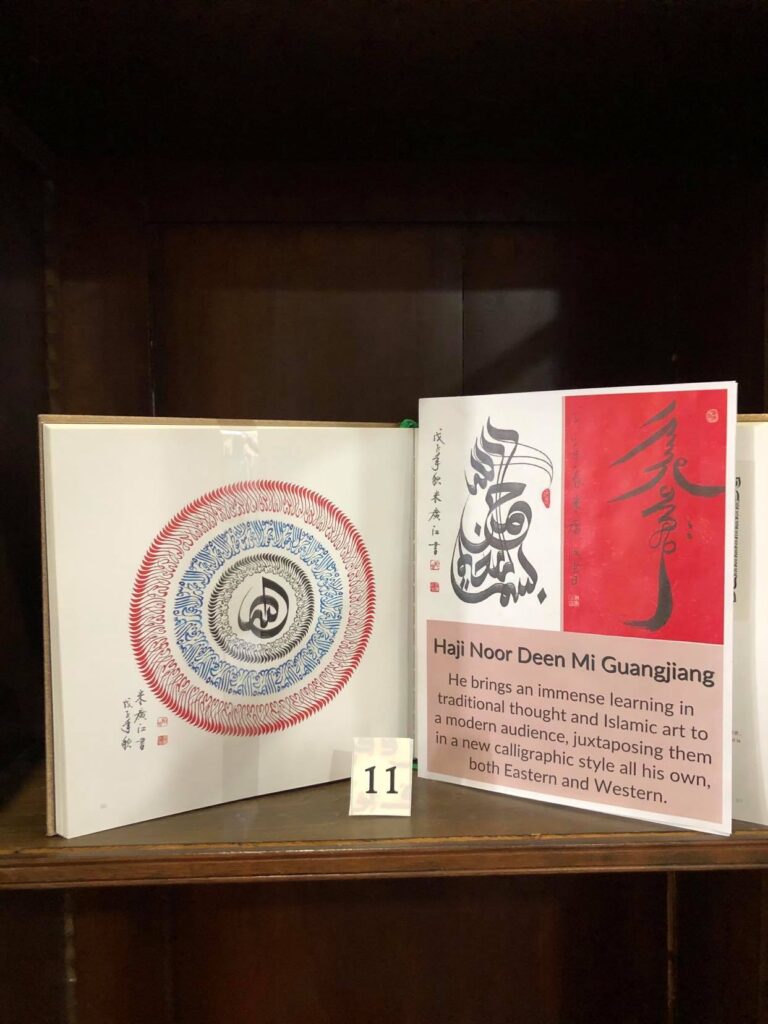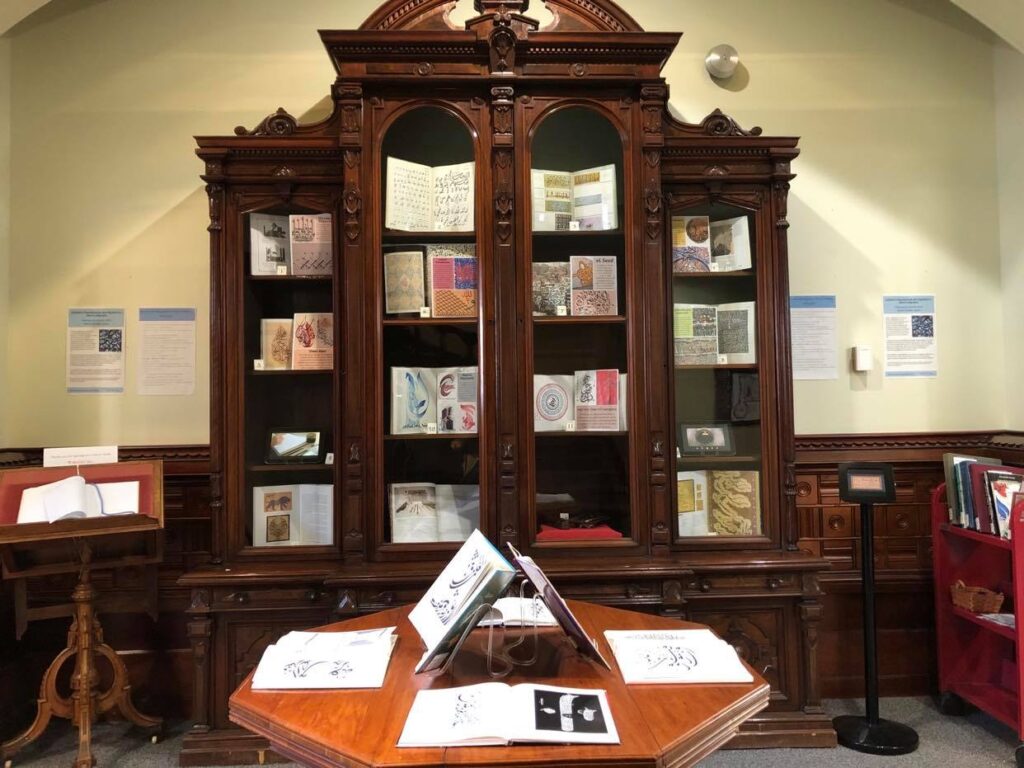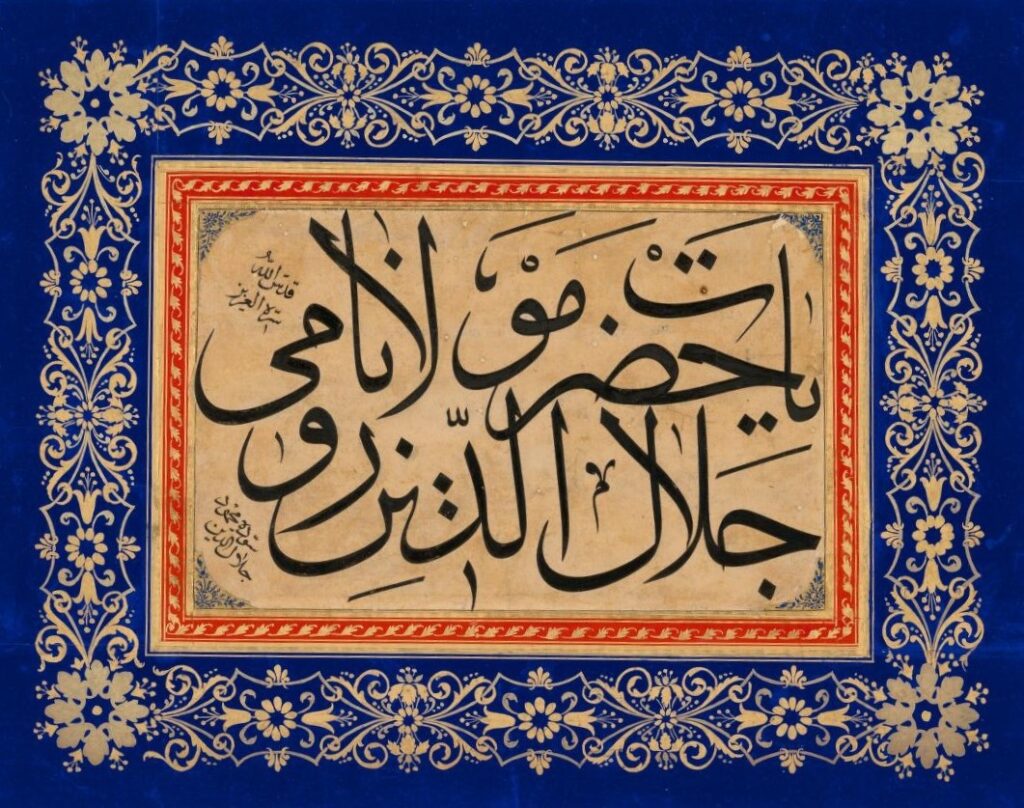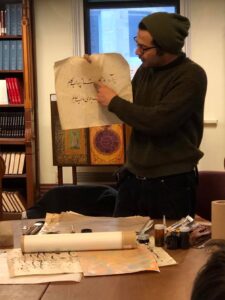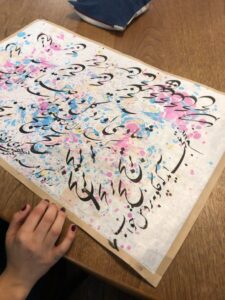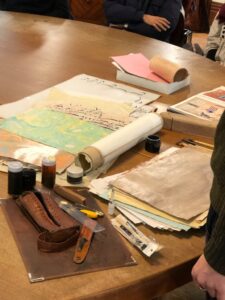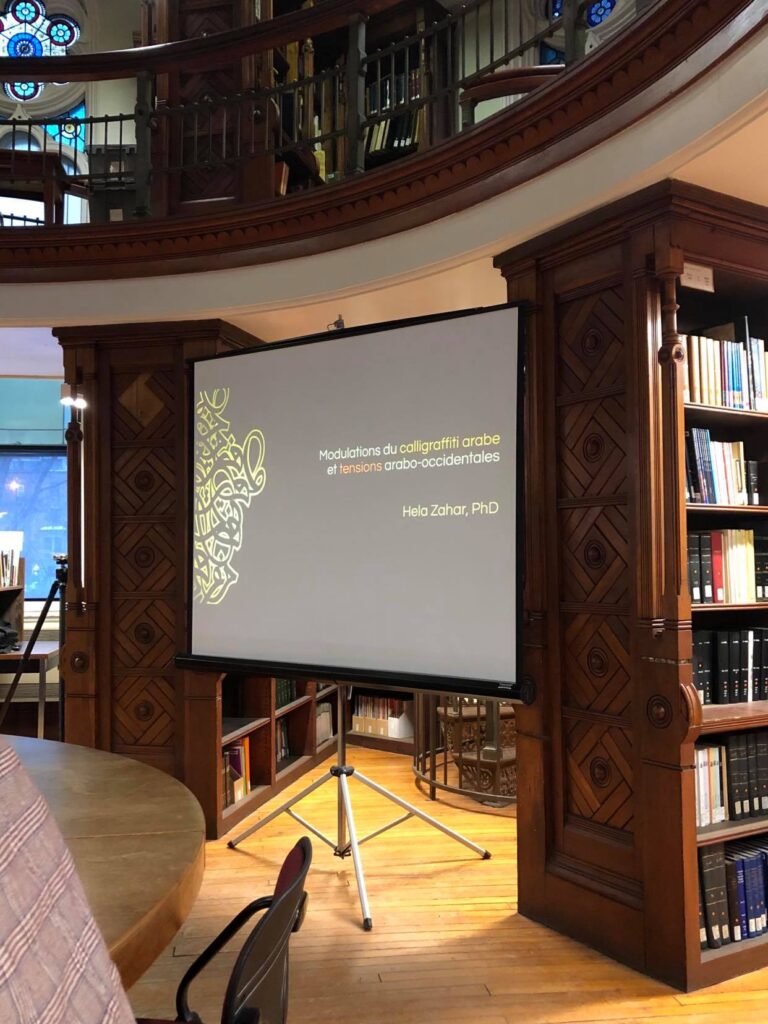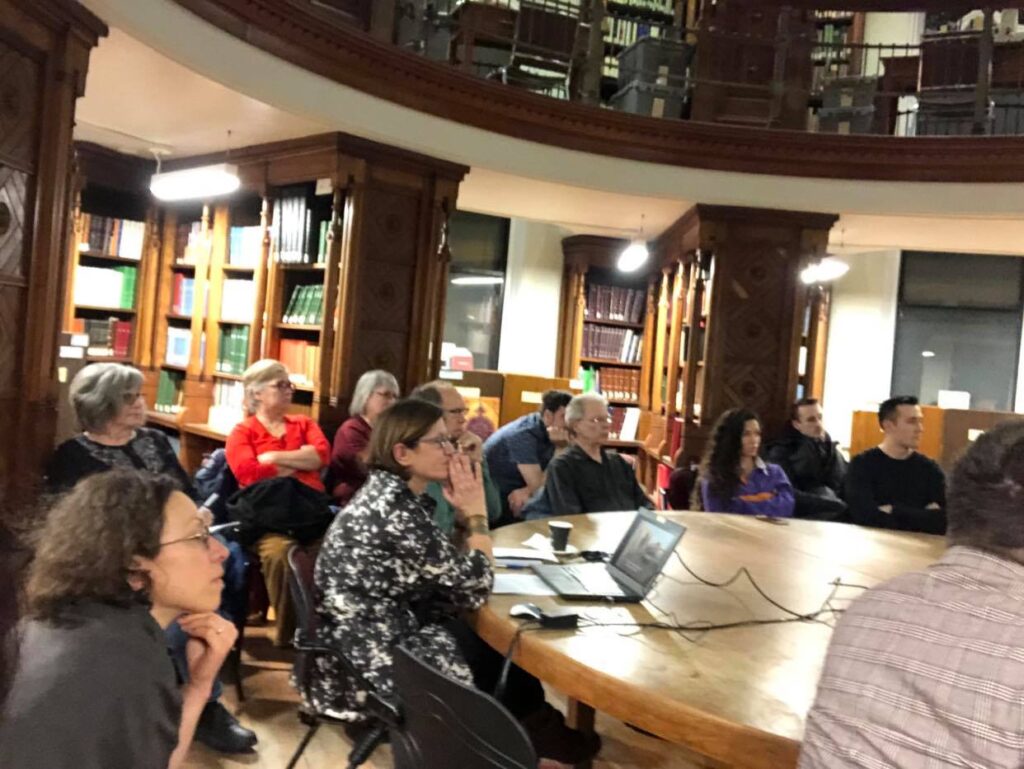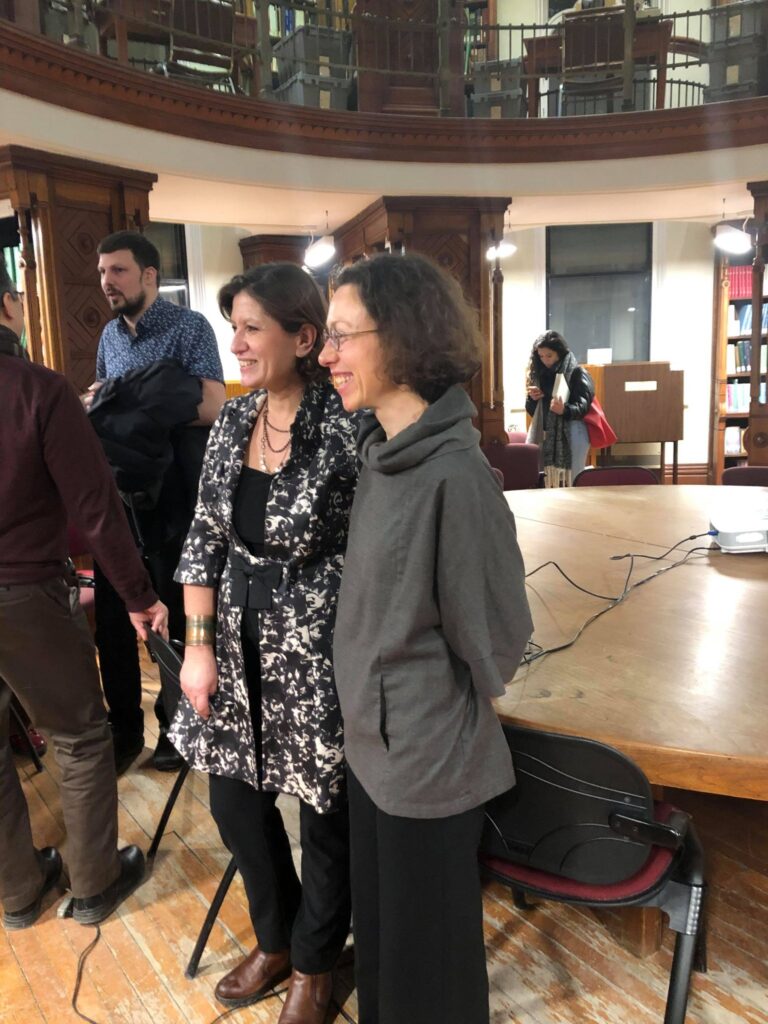Beyond words: dancing letters in Islamic calligraphy was on display in the Islamic Studies Library (ISL) from February 8th to March 13th, 2020. The library closure and service disruptions, caused by Covid-19, made the exhibition inaccessible to our students, professors and visitors. In this blog post, we will provide an overview of the exhibition, featured calligraphers, the ISL calligraphy panels collection and two events organized in conjunction with the exhibition.
Arabic calligraphy is one of the most recognizable forms of Islamic Art. While originally used to preserve the Word of God (Qur’an), Arabic calligraphy also appeared in other written texts (philosophy, literature and poetry). It further developed to represent figurative depictions and decorations that were uncommon in Islamic Art. Distinct scripts and styles like Kufic, Naskh, Raqaa, Diwani, Thuluth or Nastaliq flourished across the Muslim world often unified by specific common principles. Major elements of the Arabic script such as fluid lines and ornamentation offer contemporary calligraphers the flexibility to create a free-form twist on classic techniques, repositioning calligraphy for today’s context.
This exhibition brought together a new wave of calligraphy artists from various corners of the world united by the art of writing and the desire to break through barriers, tell a story and reach other cultures.
Featured Calligraphers
Massoudy chooses a word from the chosen quote and recreates it in much larger dimensions, with its straight lines and its curves and a new geometrical structure. Then, he writes the whole sentence underneath or on the side.
eL Seed is a street artist who uses Arabic calligraphy and a distinctive style, he calls Calligrafitti to spread messages of peace, unity and to underline the commonalities of human existence.
He is the great master of Calligraphy, praiser of the divine word. All the routes of the Mediterranean and the Middle East meet in the qalam of Ghani Alani, without contrast. His writing is not of dualities, but of harmony.
The master calligrapher, who has made the ancient Arabic tradition evolve from its religious roots, is creating deeply intellectual work that reflects his interest in modern poetry and literature, alongside Christian and Sufi philosophy.
Mahdaoui’s work inspired by Arabic calligraphy is remarkably innovative as the aesthetic dimension of letters brings forth a sense of the poetic, highly rhythmic, arresting us with its rich abstracts compositions.
Karaduman considers calligraphy art as a drawing science in aesthetical terms and conducts research and examinations in this field. He completed approximately 50 Holy Korans, verses and hilye-i sharifs by renovating, revising and imitating artworks of which some belong to calligraphy masters.
Haji Noor Deen brings an immense learning in traditional thought and Islamic art to a modern audience, juxtaposing them in a new calligraphic style all his own, both Eastern and Western.
Zenderoudi has a superb style arising from juxtaposition and simultaneous use of freedom of Western modern art and the power of decorative and visual elements of the Oriental and Iranian traditions.
ISL Calligraphy Collection
A wealth of Arabic/Islamic calligraphy titles were on display and were available for browsing. Now, these titles can be can be found via the McGill library catalog. In addition to the circulating collection, the McGill Islamic Studies Library has a permanent digital exhibit Arabic/Islamic Calligraphy displaying a selection of dry black and white calligraphy and colorful illuminated pieces dating from the 10th to the 19th century.
Calligraphy Events
The ISL hosted two events following the launch of Beyond words: dancing letters in Islamic calligraphy exhibit.
Calligraphy workshop with Mehdi Sharifi
Mehdi Sharifi is a trained calligrapher who masters a number of calligraphic methods. In January 2008, he was awarded the Best Momtaz Degree from the Iranian Calligraphers Association. In the workshop, he exhibited some of his artistic works, and demonstrated different methods for writing Nastaliq. The workshop was well attended. Participants had the chance to see firsthand various calligraphy tools and papers used in Calligraphy art. Almost everyone left with a souvenir from the calligrapher ( individual name written in calligraphic style).
A presentation by Dr. Hela Zahar, entitled Modulations du calligraffiti arabe & tensions arabo-occidentales
Dr. Hela Zahar is the director of the Lavallois Centre for Higher Education in Digital Arts and Creative Economics. Multidisciplinary, Zahar is a practitioner in calligraphy and digital arts, a teacher and researcher in urban and digital culture. Recipient of the INRS “Best Doctoral Thesis” Award (2018) and the “Cust of the Jury” Award – 5th Gala of Excellence, Maghreb Congress in Quebec (CMQ): The Way of Success (2017).
This fascinating and original talk was based on Dr Zahar’s PhD thesis defended in 2018 at the Institut National de la Recherche Scientifique (Université du Québec, Montréal). Her thesis analyzed “the political implications (…) of Arabic calligraffiti, a form of urban art that is inspired both by graffiti and Arabic calligraphy” in both Arab and Western cities. After conducting a digital and physical ethnography of calligraffiti that developed in Montreal, Paris, and some Tunisian cities between 2008 and 2017, Zahar examined the “various conflicts and power relations, such as Arab-Western tensions in the visual culture of Western cities, tensions around the religious role of Islamic calligraphy in Arab cities, tensions around urban art in all cities, and around the various digital spaces where these works are disseminated.”
The Beyond words: dancing letters in Islamic calligraphy exhibition was curated by Anaïs Salamon (Head Librarian, ISL) and Senior Library Assistants, Ghazaleh Ghanavizchian and Samah Kasha.




